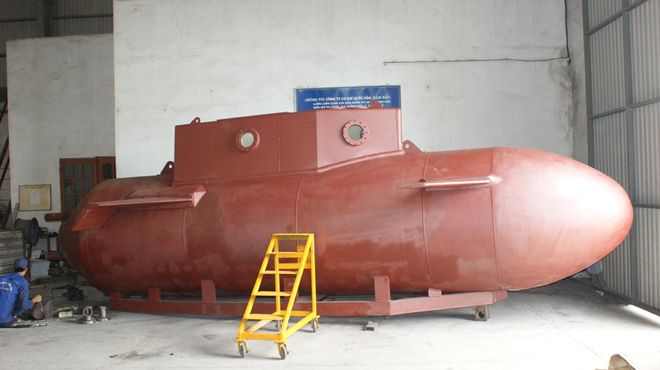
A Vietnamese engineer/buisnessman in the northern province of Thai Binh is working on his own mini-submarine, making him the second Vietnamese man who creates such vessel.
Nguyen Quoc Hoa, director of the Quoc Hoa Mechanics Ltd. Co, said he has nurtured the idea of manufacturing a mini-submarine for years but for various reasons, did not attempt to carry out the plan until one year ago, when he embarked on a careful online study of submarines.
 A Vietnamese engineer/buisnessman in the northern province of Thai Binh is working on his own mini-submarine, making him the second Vietnamese man who creates such vessel.
A Vietnamese engineer/buisnessman in the northern province of Thai Binh is working on his own mini-submarine, making him the second Vietnamese man who creates such vessel.
Nguyen Quoc Hoa, director of the Quoc Hoa Mechanics Ltd. Co, said he has nurtured the idea of manufacturing a mini-submarine for years but for various reasons, did not attempt to carry out the plan until one year ago, when he embarked on a careful online study of submarines.
His aim is to contribute to defending the country’s sea and island sovereignty, as well as help develop tourism and sea exploration.
“I learned that Vietnam has to spend hundreds of dollars to buy one submarine from Russia, while China now makes its own submarines, so I think why don’t we try to make one for ourselves—Vietnamese people are not so talentless,” said Hoa.
He started construction on his mini-sub, the Truong Sa 1, early this year with help from his firm’s engineers and workers.
The ship is 8.8 meters long, 3 meters high and 2.8 meters wide. Its shell is 15 millimeters thick and made from special steel purchased overseas.
Weighing 12 tons when submerged and 9.2 tons while afloat, the vessel, which is equipped with two 90 horsepower engines, can travel 50 meters and remain at sea for 15 days without refueling.
The Truong Sa 1 can stay submerged for 15 hours and can travel at an average speed of 40 kilometers per hour within an 800 kilometer range.
“Many difficulties have arisen while building the submarine that we thought we might not be able to overcome,” said Hoa.
The hardest part was building the sub’s prow, which took more than two months to complete, while it only took a month to build the rest of its body.
Also, the submarine is powered by diesel engines—which have difficulty operating under water.
Another difficulty was the application of the Air-Independent Propulsion (AIP) principle, which Hoa said can be studied online, but how to make it work is something no one teaches, and his team had to figure it out by trial and error. The AIP technique allows a submarine to operate without atmospheric oxygen.
As Hoa embarked on his mission, many people called it an impractical pipedream.
“I think people thought that because they were mistaking a mini-submarine with a military submarine, which operate in a completely different fashion,” said Hoa, who graduated from the Hanoi University of Science and Technology and earned a postgraduate degree in machinery at a university in Germany.
“If we don’t succeed at first, we will try again and again until it works perfectly,” Hoa pledged.
So far, he has invested over VND1 billion into the project. The total cost of building the sub will depend on equipment such as radar, a GPS system and periscope, etc.
Hoa plans to have his ship fully equipped by November, he is currently running tests a pool, which is four meters wide, 10 meters long and five meters deep.
Le Hong Bang, dean of the Shipbuilding faculty at Vietnam Maritime University refused to comment on the Truong Sa 1, saying he only recently heard about it, noting that applying the AIP technique is complicated and something not just anyone can pull off.
Rear Admiral Dinh Gia That, political commissar of the Vietnam’s People Navy, said he personally respects what Hoa is doing.
That a person dares to spend time and money to create such project is something for us to applaud and appreciate because submarines these days are not only necessary for military purposes, but also for exploring and investigating, he said.
Earlier, Phan Boi Tran, a Vietnamese engineer who worked for the French submarine firm Comex for years, returned home in 2006 and began work on his own mini sub.
He built one which is 3.2 meters long, one meter wide and 1.5 meters high, weighing around one ton. Covered in a composite shell, the ship is equipped with periscope and is battery operated. It can dive for four hours at a depth of around 70 meters, said Tran.
He spent around one year and $15,000 building the sub.
History has proven that a Vietnamese person can build a submarine. The problem now is how to utilize such vessles to help protect the country’s sea and island territory, he said.

 Previous page
Previous page Back to top
Back to top







